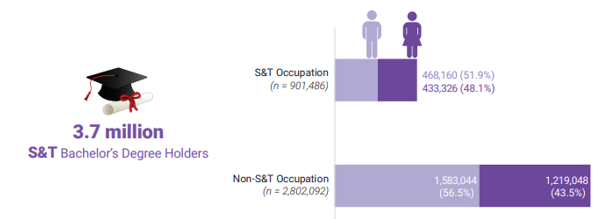Out of over 10 million bachelor’s degree holders among the Filipino household members, 3.7 million or 37 percent are graduates of S&T-related degrees, and of these 44.6 percent are females.

Image credit: DOST-SEI Women in Science Fact Sheet No. 4 available online
This is based on the Women in Science study of the Department of Science and Technology-Science Education Institute (DOST-SEI) which used 1990-2015 data collected by the Philippine Statistics Authority (PSA).
Data further showed that about 76% of S&T graduates landed in non-S&T jobs, or those which are not related to their field of study. Only 24% of those with S&T bachelor’s degree are engaged in S&T occupations or activities.
Among the 3.7 million S&T bachelor’s degree holders, some worked overseas, but with more of them landing in non-S&T occupation, than in S&T occupation.
“While it is possible that some of the S&T graduates who are not absorbed locally work overseas, the data from the PSA, however, is not sufficient to support this claim,” said Randolf Sasota, a science research specialist from DOST-SEI.
Sasota added that this result on S&T degree holders vis-à-vis occupation among overseas Filipino workers still needs verification through qualitative survey where the S&T graduates are asked about the reason why they have chosen to work abroad.
The data at hand can only tell that there is a significant low number of OFWs who are S&T bachelor’s degree graduate. It cannot specify the reason over why they work abroad; on whether or not it is solely because of the lack of opportunity to be absorbed locally or due to some other reasons.

And while it’s true that the number of female S&T workers increased by 52.3% and 30.3%, for years 1990–2000 and 2000–2010 respectively, and a strong growth was observed in 2015 with the 25.3% increase in the 2010 to 2015 period alone, most of these women-dominated occupations are nursing and midwifery at 74.4% and health at 66.2%.
In all the census years, the top three occupations with the highest proportion of female S&T workers are nursing and midwifery, health-related professions, and engineering and related professions.
The fields of mathematics, statistics, as well as architecture and related professions posted the lowest proportions of female in the S&T field.

One striking result of the research is the disproportion among the identified S&T core classification. Majority of the S&T workers are clustered in only the top three occupations: nursing and midwifery professionals, engineering and related professionals, and health professionals.
One possible solution to this is to increase the scholarship slots for the lower number of S&T occupations such as physicists, chemists, and related professionals and mathematicians, statisticians, and related professionals.




